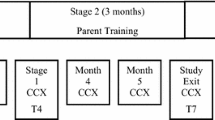Abstract
Children with communication disorders may express frustrations through challenging behaviors such as aggressive behaviors and social withdrawal. Challenging behaviors may lead to difficulties with building social competencies including emotional regulation and peer engagement. Individualized planning of functional goals for children with communication disorders provides support for social communication to increase quality classroom interactions. Teachers, families and service providers can work together to assess the purpose of the child’s behaviors in order to create more functional ways for the child to communicate as the spoken language continues to improve. This article focuses on strategies including considerations for collaboration in initial planning, communication modifications, and peer supports.
Similar content being viewed by others
Notes
Jacob is a pseudonym.
Olivia's family preferred her real name be used in any written materials.
References
American Speech-Language-Hearing Association [ASHA]. (n.d.). Definition of communication and appropriate targets. Retrieved from http://www.asha.org/NJC/Definition-of-Communication-and-Appropriate-Targets/.
Barbera, M. L. (2007). The verbal behavior approach. London, UK: Jessica Kingsley Publishers.
Brown, W. H., Odum, S. L., McConnell, S. R., & Rathel, J. M. (2008). Peer interaction interventions for preschool children with developmental disabilities. In W. H. Brown, S. L. Odom, & S. R. McConnell (Eds.), Social competence of young children (pp. 141–163). Baltimore, MD: Brookes Publishing.
Center on the Social and Emotional Foundations for Early Learning. (n.d.) Scripted stories for social situations: Tip sheet. Retrieved from http://csefel.vanderbilt.edu/scriptedstories/tips.pdf.
Conroy, M. A., Dunlap, G., Clarke, S., & Alter, P. J. (2005). A descriptive analysis of positive behavioral intervention research with young children with challenging behavior. Topics in Early Childhood Special Education, 25, 157–166.
Division for Early Childhood of the Council for Exceptional Children [DEC]. (2007). DEC Position Statement: Identification of and intervention with challenging behavior. Retrieved from http://www.dec-sped.org/papers.
Dunlap, G., & Fox, L. (2011). Function-based interventions for children with challenging behaviors. Journal of Early Intervention, 33(4), 333–343. doi:10.1177/1053815111429971.
Fujiki, M., Brinton, B., Morgan, M., & Hart, C. H. (1999). Withdrawn and sociable behavior of children with language impairment. Language, Speech, and Hearing Services in Schools, 30, 183–195.
Gilliam, W. S. (2005). Prekindergarteners left behind: Expulsion rates in state prekindergarten programs. FCD policy brief no. 3. New York: Foundation for Child Development.
Hunter, A., & Broyles, L. (2011). Communicating about challenging behavior: Helpful conversations between caregivers and parents. Zero to Three, 32(2), 12–17.
Keen, D. (2003). Communication repair strategies and problem behaviours of children with autism. International Journal of Disability, Development, and Education, 50(1), 54–64. doi:10.1080/1034912032000053331.
Matson, J. L., Boisjoli, J., & Mahan, S. (2009). The relation of communication and challenging behaviors in infants and toddlers with autism spectrum disorders. Journal of Developmental and Physical Disabilities, 21, 253–261. doi:10.1007/s10882-009-9140-1.
McCormack, J., Harrison, L. J., McLeod, S., & McAllister, L. (2011). A nationally representative study of the association between communication impairment at 4–5 years and children’s life activities at 7–9 years. Journal of Speech, Language, and Hearing Research, 54, 1328–1348. doi:10.1044/1092-4388.
McCormack, J., McLeod, S., McAllister, L., & Harrison, L. J. (2010). My speech problem, your listening problem, and my frustration: The experience of living with childhood speech impairment. Language, Speech, and Hearing Services in Schools, 41, 379–392.
McWilliam, R. A., Casey, A. M., & Sims, J. (2009). The routines based interview: A method for gathering information and assessing needs. Infants & Young Children, 22, 224–233.
Meadan, H., Ostrosky, M. M., & Halle, J. W. (2006). “What?”; “I don’t understand”; and “Pardon?”: Using communication breakdowns to encourage communication. Young Exceptional Children, 9, 2–9.
Nungesser, N. R., & Watkins, R. V. (2005). Preschool teachers’ perceptions and reactions to challenging classroom behavior. Implications for speech-language pathologists. Language, Speech, and Hearing Services in Schools, 36, 139–151.
Owens, R. E. (2010). Language disorders: A functional approach to assessment and intervention. Boston, MA: Pearson.
Roben, C. K. P., Cole, P. M., & Armstrong, L. M. (2013). Longitudinal relations among language skills, anger expression, and regulatory strategies in early childhood. Child Development, 84, 891–905.
Schneider, N., & Goldstein, H. (2008). Peer-related social competence interventions for young children with communication and language disorders. In W. H. Brown, S. L. Odom, & S. R. McConnell (Eds.), Social competence of young children (pp. 233–252). Baltimore, MD: Brookes Publishing.
Sheridan, S. M., Knoche, L. L., & Marvin, C. A. (2008). Competent families, competent children: Family-based interventions to promote social competence in young children. In W. H. Brown, S. L. Odom, & S. R. McConnell (Eds.), Social competence of young children (pp. 301–319). Baltimore, MD: Brookes Publishing.
Squires, J., & Bricker, D. (2007). An activity-based approach to developing young children’s social emotional competence. Baltimore, MD: Brookes.
Squires, J., Bricker, D., & Twombly, E. (2002). Ages and stages questionnaire: Social emotional. Baltimore, MD: Paul H. Brookes Publishing Co.
Strain, P. S., & Joseph, G. E. (2006). You’ve got to have friends: Promoting friendships for preschool children. In E. M. Horn & H. Jones (Eds.), Supporting social development in young children: DEC monograph series no. 8 (pp. 57–66). Missoula, MT: Division for Early Childhood of the Council for Exceptional Children.
Swanson, J., Raab, M. R., Roper, N., & Dunst, C. J. (2006). Promoting young children’s participation in interest-based everyday learning activities. FIPP CASEtools, 2(5), 1–22. Retrieved from http://fipp.org/static/media/uploads/casetools/casetools_vol2_no5.pd.
Author information
Authors and Affiliations
Corresponding author
Rights and permissions
About this article
Cite this article
Gregg, K. Communication Disorders and Challenging Behaviors: Supporting Children’s Functional Communication Goals in the Classroom. Early Childhood Educ J 45, 445–452 (2017). https://doi.org/10.1007/s10643-016-0789-7
Published:
Issue Date:
DOI: https://doi.org/10.1007/s10643-016-0789-7




